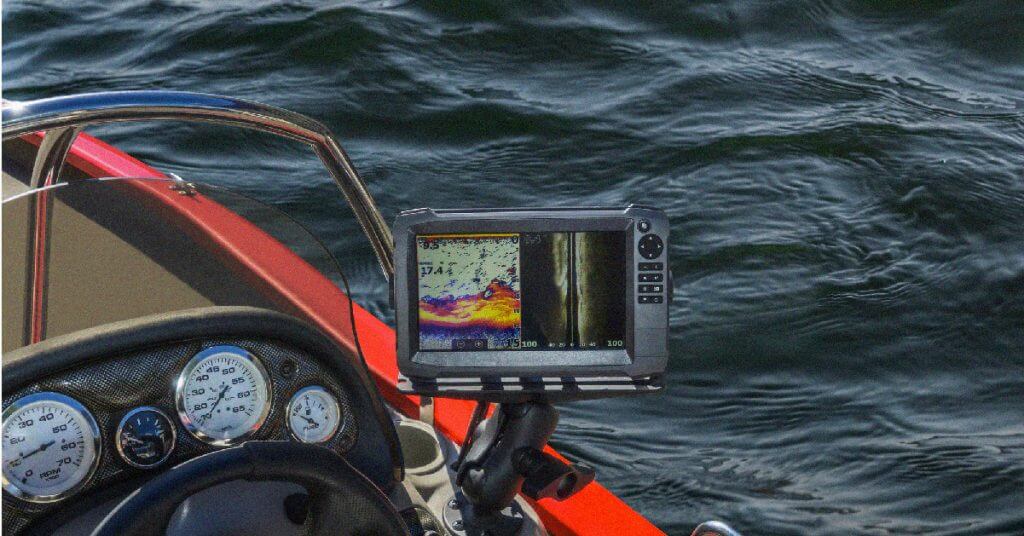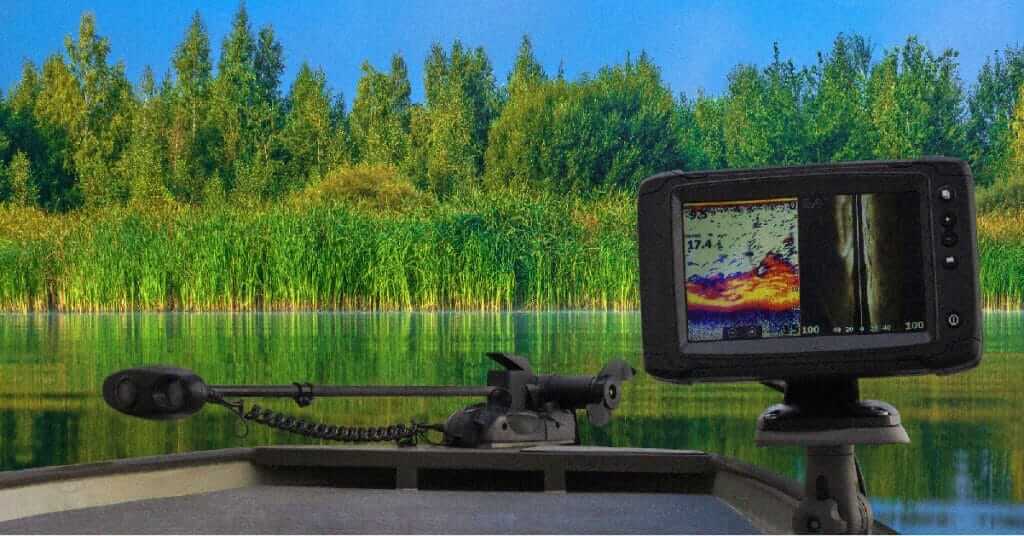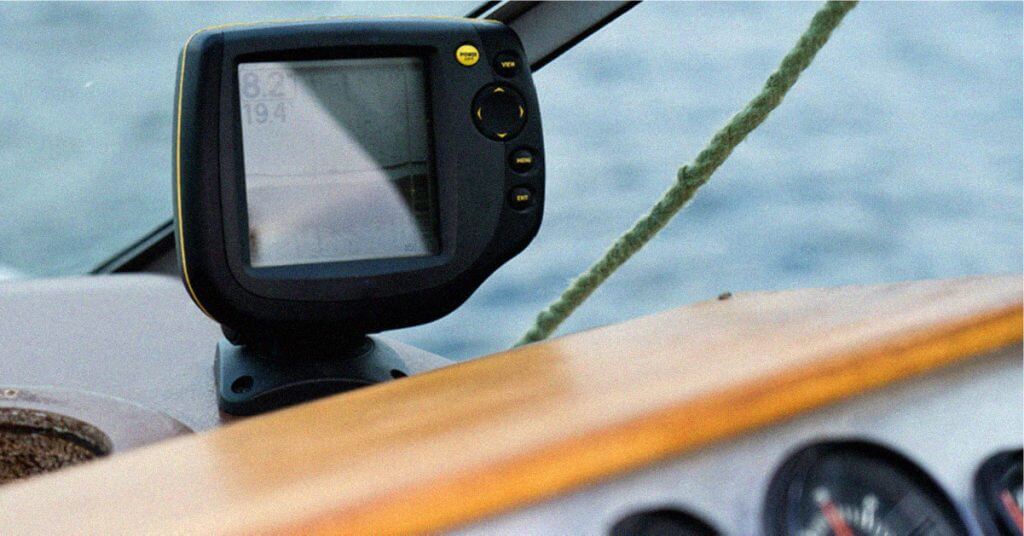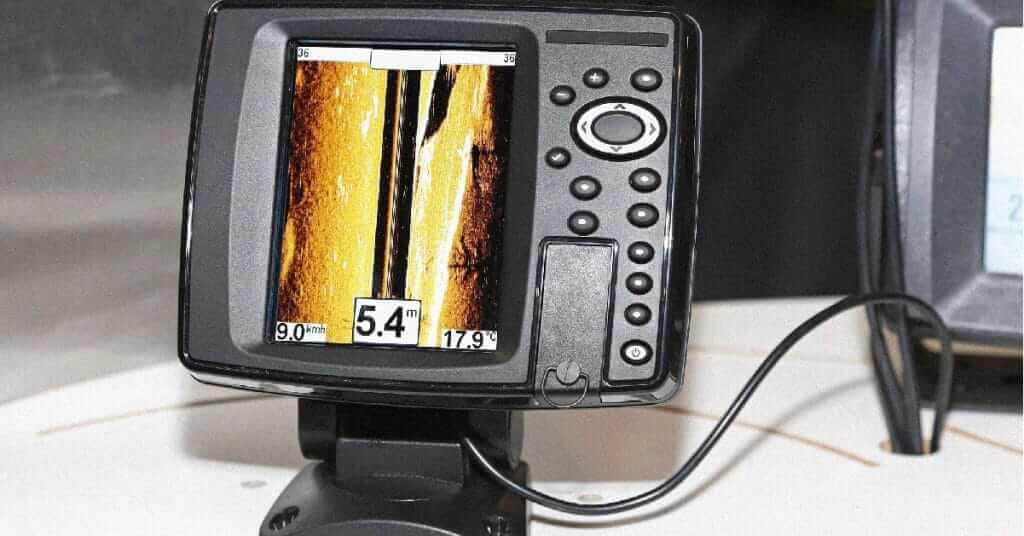While many anglers believe one is “better” than the other, down imaging and side imaging are actually two different types of sonar to help you detect fish under the water.
As someone who has used both, let me break down exactly how each one works.
Last updated: January 7th, 2025
What is Down Imaging?

Down imaging is like having an underwater flashlight pointing straight beneath your boat. The transducer sends sonar waves directly downward, creating clear images of fish and structure in a cone-shaped area below you.
A majority of fish finders in the market use down imaging (sometimes labeled as “DownVu,” “DownScan,” or “DI”) because it’s cheaper and popular for targeting smaller species like bass and panfish.
Since it shows what’s directly under your boat, it’s also easier to interpret than other sonar types.
What is Side Imaging?

Side imaging scans the water horizontally on both sides of your boat, creating a wide search pattern that covers more area. It helps you quickly scan the water because you’re capable of looking in two places at once.
Side imaging fish finders aren’t always the best choice for locating smaller fish because most people use them with trolling motors which makes it easier to cruise by schools without noticing them.
In my experience, they really shine in shallow water environments like rivers and creeks, because you can effectively scan both shorelines at once.
Down Imaging vs Side Imaging
This difference might not seem like a big deal or a difference at all. However, I firmly believe that knowing how to read your fish finder correctly can increase your chances of success on the water.
Down Imaging: Pros and Cons
Pros
- Scanning Deep Waters: More useful for deeper waters since its vertical scanning provides clear images of fish and structure directly below your boat.
- Speed and Efficiency: Typically produces higher quality images when traveling at high speeds. If you’re trying to cover a lot of water in a short amount of time, down imaging is the way to go.
- More Affordable: As someone who watches their fishing budget carefully, I appreciate that down imaging often costs less than other options (not always though), especially through GPS fish finder combos.
Cons
- Limited Coverage Area: The single transducer setup means you’ll only see what’s directly under your boat. This can also result in lower-quality images with less resolution.
- More Time Searching: Even though the imaging works at higher speeds, you’ll need to drive over every spot you want to check. In other words, since it’s vertical images, you won’t get horizontal information like a side imaging fish finder, leading to the need to cover more water.
- Quality Concerns: Since down imaging is often marketed as the budget option compared to side imaging, some manufacturers may cut corners. This increases the chances of you purchasing a bad product and having to send it back.
Side Imaging: Pros and Cons
Pros
- Wider Coverage: Using two transducers, side imaging lets you scan in both directions simultaneously, giving you a full view of what’s happening on each side of your boat.
- Complete Package: Side imaging units typically come as premium models that include down imaging capability as well. This means you can switch between views to get the most complete picture of your surroundings without missing anything.
- Better Image Quality: The dual transducer setup combined with slower boat speeds often results in clearer, more detailed images compared to down imaging.
- Shallow Water Excellence: I think side imaging is the best choice in shallow waters or rivers because it picks up a better reading since it can’t go as deep as down imaging scanners. In smaller rivers, you might even cover the entire width with a single pass.
Cons
- Higher Cost: Side imaging systems come at a premium price since they include both side and down imaging capabilities. While some units allow you to upgrade from down to side imaging later, the initial investment is typically higher.
- Limited Depth Performance: I find side imaging’s main drawback to be its reduced effectiveness in deeper water. It works best in shallow waters under 10 feet – beyond that, image quality can start to suffer.
- Speed Restrictions: These units require you to travel at a slower speed for developing proper images. This could be a good or bad thing.
While this slower pace might help you spot things you’d otherwise miss, it does mean covering water takes more time. It all depends on the range of your model.
Is One “Better” Than The Other?

Both of these fish finders have their purpose with pros and cons. They operate differently and I find that they work best when put together.
That’s the reason why I recommend buying a down imaging and side imaging combo if your budget allows. You’ll often see these marketed as “dual scan” or “triple threat” on Amazon by major brands like Garmin, Humminbird, and Lowrance HDS.
You’ll often see the term “Chirp” mentioned with both types. This refers to the 2D sonar technology that provides a continuous flow of data from the unit to help you spot fish.
Choosing the right technology really comes down to your fishing style:
- Shallow River Fishing: If you primarily fish shallow rivers, side imaging is your best bet. Down imaging will do you no good.
- Deep Water Fishing: If you’re the type who anchors in deeper spots and waits for fish to come to you, a down imaging unit will serve you well.
- Ice Fishing: Down imaging is the clear winner here. You need to see what’s directly below your fishing hole, and side imaging won’t function properly through ice anyway.
The best choice depends on where and how you plan to fish. For many anglers who fish various waters, a combo unit offering both technologies provides the most versatility.
Frequently Asked Questions
What is better for trolling – side imaging or down imaging?
If you spend most of your days on the water with a troll rod, you’ll need a side imaging fish finder. Side imaging is the ideal choice when you’re moving at a slow but steady pace. Plus, you’re getting images on both sides of the boat so you don’t have to fish in only one direction.
What does down imaging sonar and side image sonar mean?
Sonar simply refers to the way the sonar waves penetrate the water and bounce off of things. That’s what your fish finder does. It saves ultrasound waves into the water and they continue until they hit something. Then the result is displayed on the screen as an obstruction. It’s up to you to then determine if it’s weeds, a stump, or a fish.
Over time, fish finders have gotten much better at making that determination for us though.
Should I use side imaging or down imaging on a kayak?
The best kayak fish finder really depends on how you fish. If you need to scan a large amount of water on both sides, you’ll want a side imaging device. Chances are you’re fishing shallow backwater ponds and rivers with a kayak. If that’s the case then you’ll benefit from side imaging as well. Just keep in mind that they’re more expensive.
Can you use side imaging sonar to pick up on structure?
Some fish finders like the Humminbird Helix 5 have something called “structurescan.” This is different from traditional sonar and it helps you identify structure. Not every fish finder can do that.
Final Thoughts
By this point, you should clearly understand the differences and similarities between these two types of sonar. In reality, you could easily get by with either of these. Side imaging is an upgrade but it’s not necessarily “better.”
Think of it more as, “in addition to.” Side imaging is beneficial because it provides you with more flexibility in terms of your imaging but that doesn’t make it “better.”
It’s like comparing apples to oranges. I hope this squashes the down imaging vs. side imaging debate and helps shed a little light for you. Good luck and happy casting!





Awesome thanks alot.
I’m glad this was able to help you!!! :)
Terrific article. I read several others and was more confused. I fish mostly creeks and rivers and your answer on that was crystal clear.
Hey Roscoe, thanks so much – I really appreciate that! Thanks for reading
Très bon article!
Merci!
This helped me immensely. I was totally confuse. I’m just getting back into fishing and the technology has greatly changed. Thank you.
Comments like these really make my day so thank you. Fish finding technology keeps getting more and more complicated but I’ll be honest, a lot of the fancy features in many of these new fish finders are totally unnecessary. Sometimes sticking to the basics works best!
How far from the boat does “side imaging” extend????? Just wondering about hooking one up on the dock I fish from???????
It extends 23ft. With a 6ft. wide by 15ft. long “T” on it, meaning my rod is at 29ft. from shore, & if side imaging can add 25ft. more, I would know how deep to fish!!!!!!
Hey John, how far the side imaging extends depends on your unit! It’s hard for me to say without knowing what fish finder you have. Some offer ranges up to 150-200 feet. Check out our guide on the best fish finders if you’re looking to increase your range. Thanks for reading!
Thank you so much. This was great help.
Thank you!
Is Side Imageing better than Down Imageing??? Are U kidding me!?! Compareing S.I to D.I is like compareing Nascar to F1? When it comes to Freshwater Fishing, D.I offers very little in comparison, where the only combination 2seriously consider is “2D Sonar + S.I” and simply skip D.I & any combo views thereof altogether in order 2maximize your time on the water.
However, the only point this article made that I could “partially” agree with would pertain 2thoughts expressed where D.I. would be more helpful in DeepWater Fishing conditions and when I say this – it would pertain strictly to Saltwater Fishing ONLY as 1 must consider the amount of RMS Power required 2maintain consistent S.I readings due 2the increase in Density.
Now with that being said, Saltwater Fishing by it’s very nature usually means Deeper Water than the vast majority of Freshwater Fishing condititions the Avg Fisherman will encounter.
Saltwater Fishing is the 1 and only place where D.I “might be” more useful (perhaps “reliable” might be a better word) than S.I. and other than that, S.I. is hands down, beyond a shadow of a doubt, superior to D.I. in just about any/every aspect imaginable – especially when it comes to Freshwater Fishing.